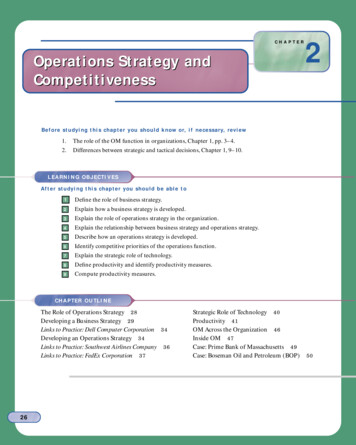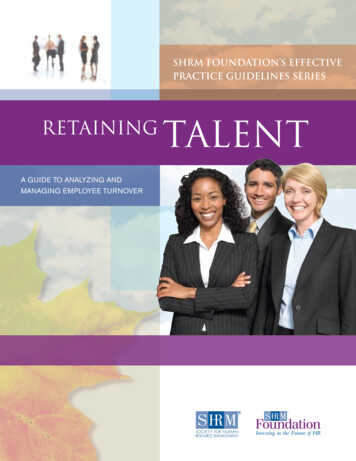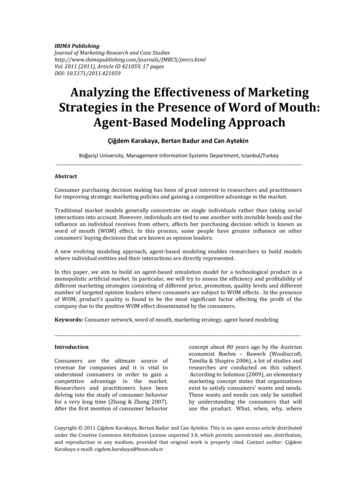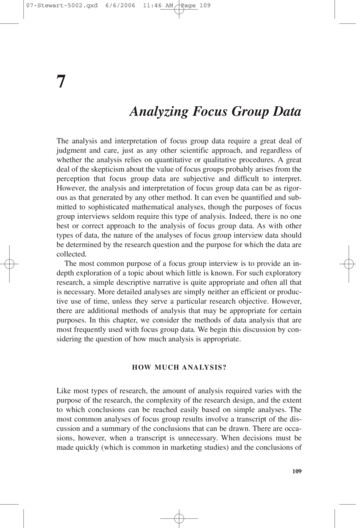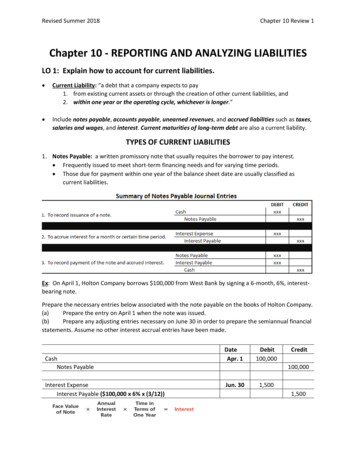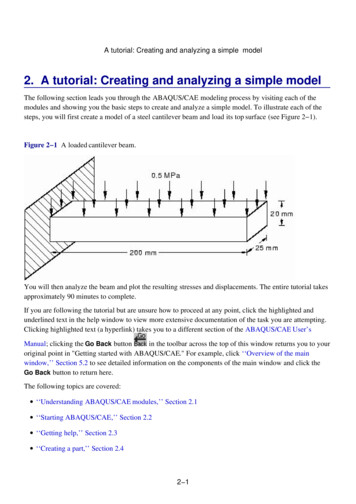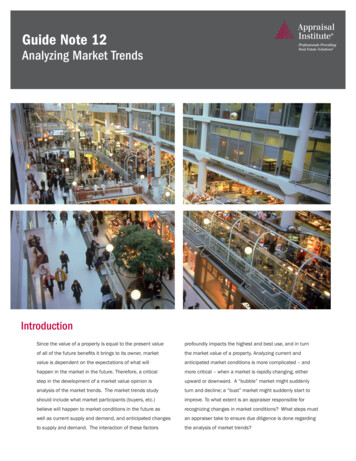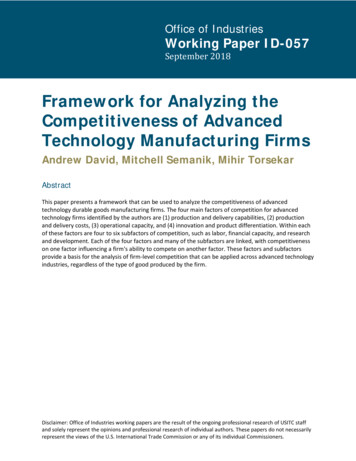
Transcription
Office of IndustriesWorking Paper ID-057September 2018Framework for Analyzing theCompetitiveness of AdvancedTechnology Manufacturing FirmsAndrew David, Mitchell Semanik, Mihir TorsekarAbstractThis paper presents a framework that can be used to analyze the competitiveness of advancedtechnology durable goods manufacturing firms. The four main factors of competition for advancedtechnology firms identified by the authors are (1) production and delivery capabilities, (2) productionand delivery costs, (3) operational capacity, and (4) innovation and product differentiation. Within eachof these factors are four to six subfactors of competition, such as labor, financial capacity, and researchand development. Each of the four factors and many of the subfactors are linked, with competitivenesson one factor influencing a firm's ability to compete on another factor. These factors and subfactorsprovide a basis for the analysis of firm-level competition that can be applied across advanced technologyindustries, regardless of the type of good produced by the firm.Disclaimer: Office of Industries working papers are the result of the ongoing professional research of USITC staffand solely represent the opinions and professional research of individual authors. These papers do not necessarilyrepresent the views of the U.S. International Trade Commission or any of its individual Commissioners.
Framework for Analyzingthe Competitiveness ofAdvanced TechnologyManufacturing FirmsAndrew David, Mitchell Semanik, MihirTorsekarOffice of Industries and Office of EconomicsU.S. International Trade Commission (USITC)September 2018The authors are staff with the Office of Industries andthe Office of Economics of the U.S. International TradeCommission (USITC). Office of Industries working papersare the result of the ongoing professional research ofUSITC staff. Working papers are circulated to promotethe active exchange of ideas between USITC staff andrecognized experts outside the USITC, and to promoteprofessional development of office staff by encouragingoutside professional critique of staff research.Address Correspondence To:Office of IndustriesU.S. International Trade CommissionWashington, DC 20436 USAFramework for Analyzing theCompetitiveness of AdvancedTechnology Manufacturing Firmswww.usitc.govThis paper represents solely the views of the authorsand is not meant to represent the views of the U.S.International Trade Commission or any of itsCommissioners. Please direct all correspondence toAndrew David, Mitchell Semanik, or Mihir Torsekar,Office of Industries, U.S. International TradeCommission, 500 E Street, SW, Washington, DC 20436,telephone: 202-205-3368, 202-205-2034, or 202-2053350, fax: 202-205-3161, email:Andrew.David@usitc.gov, Mitchell.Semanik@usitc.gov,or Mihir.Torsekar@usitc.gov.
Framework forAnalyzing theCompetitiveness ofAdvanced TechnologyManufacturing FirmsSeptember 2018No. ID-18-057
This working paper was prepared by:Andrew David, Andrew.David@usitc.govMitchell Semanik, Mitchell.Semanik@usitc.govMihir Torsekar, Mihir.Torsekar@usitc.govAdministrative SupportMonica SandersThe authors would like to thank Robert Feinberg, John Fry, Tamar Khachaturian, Dan Kim, Linda Linkins,and James Stamps for their helpful comments and suggestions and Monica Sanders for heradministrative support.
Advanced Technology FirmsIntroductionThe ability of manufacturing firms to compete in advanced technology industries is increasingly drivenby a broad range of competencies, some of which were only minor considerations a generation ago. Aswith all manufacturing firms, low production costs are important for a firm to gain and maintaincompetitiveness in its industry. Modern technology-driven firms, however, also need to supply valueadded services, provide effective cybersecurity, use advanced data analytics, and generate innovativeproducts and processes in order to be competitive. In order to assess the relative competitiveness ofthese advanced technology firms in relation to each other, it is helpful to have a comprehensive outlineof the factors needed to compete in advanced technology industries. This paper, therefore, provides aframework to analyze competition among advanced technology durable goods manufacturing firms,laying out the major factors that need to be considered in an analysis of firm competitiveness.The framework in this paper is designed to assess the competitiveness of advanced technology firms,rather than advanced technology industries. This paper uses firm activities, assets (e.g., intellectualproperty), and capabilities as the basis for a competitiveness framework, which are referred to as factorsand subfactors of competition. The specific factors were selected based on an extensive review of theacademic literature, media reports, business literature, etc. The authors also reviewed factors ofcompetition that firms self-identified, including through a review of company financial reports. Finally,the authors reviewed competitiveness factors identified for advanced technology industries and firms inU.S. International Trade Commission (Commission) studies.The next section of the paper will define advanced technology firms, and the following section willprovide an overview of the research that provides the theoretical foundation for the framework. Themain focus of the paper is the subsequent sections, which introduce the framework and discuss eachfactor and subfactor of competition in more detail.Definition of Advanced Technology FirmsThe purpose of this paper is to develop a framework that applies to advanced technology durable goodsmanufacturing firms. Examining widely used definitions from the Bureau of Labor Statistics (BLS),International Trade Administration (ITA), and Brookings Institution, four durable goods North AmericanIndustry Classification System (NAICS) manufacturing subsectors are identified as containing high-techor advanced industries by all sources: (1) machinery manufacturing (NAICS 333); (2) computer andelectronic product manufacturing (334); (3) electrical equipment, appliance, and componentmanufacturing (335); and (4) transportation equipment manufacturing (336). 1 The framework in thispaper is designed to apply to these four subsectors as well as miscellaneous manufacturing (337)BLS and Brooking define the industries at the NAICS 4-digit (industry group) level. Each of the 3-digit NAICSincluded here has at least one 4-digit NAICS on the BLS and Brookings List. The ITA list is at the three-digit(subsector) level. The industries covered in this paper (which is not a detailed analysis of individual industries) areat the 3-digit subsector level. Wolf and Terrell, “The High-Tech Industry,” May 2016; USDOC, ITA, “High-TechIndustries,” 2017, 3; Muro et al., America’s Advanced Industries, February 2015, 21.1U.S. International Trade Commission 1
Framework for Analyzing the Competitiveness of Advanced Technology FirmsAppendix A). 2 Miscellaneous manufacturing is included here (though not in all definitions of advancedmanufacturing) as it includes medical devices not covered by the other NAICS subheadings.The five subsectors covered here are research and development (R&D) and information andcommunications technology (ICT) intensive, as would be expected from advanced technology industries(figure 1). 3 These industries are also heavy users of advanced production technology. The automotiveindustry, for example, is the largest user of industrial robots per 1,000 workers, and the aerospace andautomotive industries contain the largest share of firms that expect to use 3D printing. 4Figure 1 ICT and R&D intensity of advanced technology durable goods subsectorsPercent2015105ICT share ofexpendituresShare of employees incomputer occupationsSubsector shareShare of employeesin R&DMiscellaneousTransportationElectrical, appliancesComputers, ctrical, appliancesComputers, ctrical, appliancesComputers, ctrical, appliancesComputers, electronicsMachinery0R&D spending as ashare of salesMedian all manufacturingSource: DOL, BLSs, “May 2017 National Industry-Specific Occupational,” March 30, 2018; Census Bureau, “Annual Survey ofManufactures,” December 15, 2017; NSF, “Business Research and Development,” March 12, 2018, tables 17 and 47.Notes: The ICT share of expenditures are capital and other expenditures (based on the Annual Survey of Manufactures) oncomputers and software equipment and services as a share of all capital and other expenditures. The share of employees incomputer occupations are the share of workers defined as “computer and information systems managers” (occupational code11-3021), “computer occupations” (15-1100), and “computer hardware engineers” (17-2060). The share of employees in R&D isglobal employment by respondents to the National Science Foundation’s (NSF) survey. R&D spending is domestic R&D spendingpaid for by the company and others as a share of domestic net sales.As this is a firm-level framework, and goods and services are inextricably tied together in many of thesefirms, this framework does not separate goods and services provided by firms within the five coveredThis framework can be applied to analyze the competitiveness of firms at any level (such as the subsector,industry group, or industry level). For example, it could be used to analyze the competitiveness of all agriculturalequipment manufacturers or those that specifically produce lawn and garden equipment.3This methodology for ICT intensity is adapted from USITC, Digital Trade, July 2013, 3-2–3-4.4Acemoglu and Restrepo, “Robots and Jobs,” March 2017, A-14; Ernst and Young, EY’s Global 3D Printing, 2016,19.22 www.usitc.gov
Advanced Technology Firmssubsectors. As will be discussed below, many advanced technology firms offer embedded or relatedservices that enhance the value of products and may increase firm competitiveness and profitability.Activities, Assets, and Capabilities as theFoundation of Competitive AdvantageThe framework proposed for this analysis builds on the work of Michael Porter, who proposed that afirm’s activities are the basis for its competitive advantage. 5 A firm, according to Porter, performs a setof activities that include all of the steps in producing and delivering a product to customers, as well asrelated support activities such as technology development and procurement. A firm can develop acompetitive advantage if it is able to combine these activities or perform them in a unique way thatleads to either lower costs or a differentiated product that provides more value to customers and cansell at a higher price. While there are hundreds of possible activities, Porter divides them into ninecategories, and then further into general areas of primary activities—which are all activities related toproducing and delivering the product to customers—and support activities that are not explicitly part ofthe primary activity, but may impact all of the primary activities. 6 While described separately, theactivities are linked and improvements in one area may contribute to competitive advantage in anotherarea. 7Chris Zook and James Allen state that competitive advantage derives from a firm’s ability to differentiateitself from its competitors. 8 According to Zook and Allen, firms can differentiate themselves via“superior cost economics, unique product features, or control over a key position in a larger economicsystem.” 9 They identify more than 250 types of differentiation, which they group into 15 “clusters” inthree categories: management systems, operating capabilities, and assets. 10 For the purposes of thispaper, the key addition to Porter’s work is the inclusion of assets as a source of competitive advantage.Deloitte indicates that it is the capabilities of manufacturers that differentiate them and provide themwith a competitive advantage. 11 According to Deloitte, these “capabilities, when coupled together, areMichael Porter’s framework applies to all firms, and not just the advanced technology durable goodsmanufacturing firms covered in this paper.6Primary activities are inbound logistics, operations, outbound logistics, marketing and sales, and after-salesservice. Support activities are firm infrastructure, human resources management, technology development, andprocurement. Porter, “Competitive Advantage: Enduring Ideas and New Opportunities,” June 22, 2012, 6.7Porter, “What is Strategy?” 2008, 38; Porter and Millar, “How Information Gives You Competitive Advantage,”2008, 75–77.8Zook and Allen, Repeatability, 44–45.9An example of this last type of differentiation would be Intel’s position in supplying processors for personalcomputers. Zook and Allen, Repeatability, 45–46.10Management systems include portfolio management and finance; mergers and acquisitions, joint ventures, andpartnering; regulatory management; business unit strategy and driving priorities; and human resourcesmanagement and culture. Operating capabilities include supply chain and logistics; production and operations;development and innovation; go-to-market; and customer relationships. Assets include tangible assets; scale;technology and intellectual property; brand; and tied customer network. Zook and Allen, Repeatability, 47–49.11Deloitte Center for Industry Insights, High-performing Manufacturers, 2016, 1.5U.S. International Trade Commission 3
Framework for Analyzing the Competitiveness of Advanced Technology Firmsdifficult for their competitors to replicate, and when executed well, they create long-term competitiveadvantage by generating greater customer loyalty, higher market share, and superior profitability.” 12Further, certain “capabilities will enable the organization to create unique value and consistently deliverthat value to customers in a way that is distinct from competitors’ offerings.” 13Propos
computers and software equipment and services as a share of all capital and other expenditures. The share of employees in computer occupations are the share of workers defined as “computer and information systems managers” (occupational code 11-3021), “computer occupations” (15-1100), and “computer hardware engineers” (17-2060). The share of employees in R&D is

